Damage Identification in Hangers of Through-Arch Bridges Using Static Deflection Difference at the Anchorage Point
Abstract
:1. Introduction
2. Damage Identification Method of Hangers
3. Verification by a Two-Dimensional Finite Element Model
3.1. Finite Element Modeling
3.2. Extreme Damage Cases and Identification Results
3.3. Influence of Material Creep and Structural Stiffness Degradation
4. Experimental Verification
4.1. Introduction of the Test Model
4.2. Damage Cases
4.3. Damage Identification Results
4.4. Experimental Verification of Hanger Damage Identification Considering Creep and Bridge Stiffness Degradation
5. Discussions on Practical Applications
6. Conclusions
Author Contributions
Funding
Institutional Review Board Statement
Informed Consent Statement
Data Availability Statement
Acknowledgments
Conflicts of Interest
References
- García-Guerrero, J.M.; Jorquera-Lucerga, J.J. Effect of Stiff Hangers on the Longitudinal Structural Behavior of Tied-Arch Bridges. Appl. Sci. 2018, 8, 258. [Google Scholar] [CrossRef] [Green Version]
- Nazarian, E.; Ansari, F.; Zhang, X.; Taylor, T. Detection of Tension Loss in Cables of Cable-Stayed Bridges by Distributed Monitoring of Bridge Deck Strains. J. Struct. Eng. 2016, 142, 04016018. [Google Scholar] [CrossRef]
- Mehrabi, A.B. In-Service Evaluation of Cable-Stayed Bridges, Overview of Available Methods and Findings. J. Bridge Eng. 2006, 11, 716–724. [Google Scholar] [CrossRef]
- Bao, Y.; Shi, Z.; Beck, J.L.; Li, H.; Hou, T.Y. Identification of time-varying cable tension forces based on adaptive sparse time-frequency analysis of cable vibrations. Struct. Control. Health Monit. 2016, 24, e1889. [Google Scholar] [CrossRef]
- Alamdari, M.M.; Dang Khoa, N.L.; Wang, Y.; Samali, B.; Zhu, X. A multi-way data analysis approach for structural health monitoring of a cable-stayed bridge. Struct. Health Monit. 2019, 18, 35–48. [Google Scholar] [CrossRef]
- Li, H.; Ou, J.P. The state of the art in structural health monitoring of cable-stayed bridges. J. Civil Struct. Health Monit. 2016, 6, 43–67. [Google Scholar] [CrossRef]
- Chen, H.; He, W.; He, R. Damage identification for suspender of through and half-through arch bridges based on displacement differences of monitoring points. China J. Highw. Transp. 2012, 25, 83–88. [Google Scholar]
- Ho, H.-N.; Kim, K.-D.; Park, Y.-S.; Lee, J.-J. An efficient image-based damage detection for cable surface in cable-stayed bridges. NDT E Int. 2013, 58, 18–23. [Google Scholar] [CrossRef]
- Xiang, Y.Q.; Jia, Y.K. Damage detection of hangers in arch bridges based on relative variation of wavelet total energy. J. Zhejiang Univ. (Eng. Sci.) 2017, 51, 870–878. [Google Scholar]
- Peeters, B.; De Roeck, G. One-year monitoring of the Z24-Bridge: Environmental effects versus damage events. Earthq. Eng. Struct. Dyn. 2001, 30, 149–171. [Google Scholar] [CrossRef]
- Wang, S.J. Design and Damage Static & Dynamic Analysis of a Concrete-Filled Steel Tube Arch Bridge Model. Master′s Thesis, Shantou University, Shantou, China, 2004. [Google Scholar]
- Huang, C.; Luo, R.; Han, X.J. Damage detection of tied-arch bridge based on curvature modal method. J. Nanjing Tech Univ. Nat. Sci. Ed. 2015, 37, 88–93. [Google Scholar]
- Farrar, C.R.; Doebling, S.W.; Cornwell, P.J.; Straser, E.G. Variability of modal parameters measured on the Alamosa Canyon bridge. In Proceedings of the International Modal Analysis Conference, Orlando, FL, USA, 3–6 February 1997. [Google Scholar]
- Soo Lon Wah, W.; Chen, Y.-T.; Roberts, G.W.; Elamin, A. Separating damage from environmental effects affecting civil structures for near real-time damage detection. Struct. Health Monit. 2018, 17, 850–868. [Google Scholar] [CrossRef]
- Zhao, X.; Yu, Y.; Hu, W.; Jiao, D.; Han, R.; Mao, X.; Li, M.; Ou, L. Cable Force Monitoring System of Cable Stayed Bridges Using Accelerometers Inside Mobile Smart Phone. Proc. SPIE—Int. Soc. Opt. Eng. 2015, 9435, 94351H. [Google Scholar]
- Shen, P.; Yan, X.R. Analysis of cable replacement method for stay cables of Yonghe Bridge in Tianjin. J. Highw. Transp. Res. Dev. 2011, 4, 47–51. [Google Scholar]
- Zhou, P.; Huang, L.G. Construction control and monitoring of cable replacement project of Huxi bridge in Liuzhou. Urban Roads Bridges Flood Control 2007, 3, 70–74. [Google Scholar]
- Mehrabi, A.B.; Ligozio, C.A.; Ciolko, A.T.; Wyatt, S.T. Evaluation, Rehabilitation Planning, and Stay-Cable Replacement Design for the Hale Boggs Bridge in Luling, Louisiana. J. Bridge Eng. 2010, 15, 364–372. [Google Scholar] [CrossRef]
- Zhong, J.T. Study on Relative Slip between Wires and Damage Identification of Stayed Cables. Ph.D. Thesis, South China University of Technology, Guangzhou, China, 2019. [Google Scholar]
- Zhang, L.; Qiu, G.; Chen, Z. Structural health monitoring methods of cables in cable-stayed bridge: A review. Measurement 2021, 168, 108343. [Google Scholar] [CrossRef]
- Lin, S.-W.; Yi, T.-H.; Li, H.-N.; Ren, L. Damage Detection in the Cable Structures of a Bridge Using the Virtual Distortion Method. J. Bridge Eng. 2017, 22, 04017039. [Google Scholar] [CrossRef]
- Mohammad Zarbaf, S.E.H.A.; Norouzi, M.; Allemang, R.J.; Hunt, V.J.; Helmicki, A.; Nims, D.K. Stay Force Estimation in Cable-Stayed Bridges Using Stochastic Subspace Identification Methods. J. Bridge Eng. 2017, 22, 4017055. [Google Scholar] [CrossRef]
- Kim, B.H.; Park, T. Estimation of cable tension force using the frequency-based system identification method. J. Sound Vib. 2007, 304, 660–676. [Google Scholar] [CrossRef]
- Tan, Y.; An, Y.; Zhong, Y.; Ou, J. Experimental and numerical studies on a test method for damage diagnosis of stay cables. Adv. Struct. Eng. 2017, 20, 245–256. [Google Scholar]
- Li, H.; Ou, J.; Zhou, Z. Applications of optical fiber Bragg gratings sensing technology-based smart stay cables. Opt. Lasers Eng. 2009, 47, 1077–1084. [Google Scholar] [CrossRef]
- Le, N.; Thambiratnam, D.; Nguyen, A.; Chan, T. A new method for locating and quantifying damage in beams from static deflection changes. Eng. Struct. 2018, 180, 779–792. [Google Scholar] [CrossRef]
- Huang, Z.K. Damage Identification of the Main Girder of Cable-Stayed Bridge and Arch Bridge Based on the Cable Force Influence Line. Master′s Thesis, Guangzhou University, Guangzhou, China, 2016. [Google Scholar]
- Huang, Y.; Wang, Y.; Fu, J.; Liu, A.; Gao, W. Measurement of the real-time deflection of cable-stayed bridge based on cable tension variations. Measurement 2018, 119, 218–228. [Google Scholar] [CrossRef]



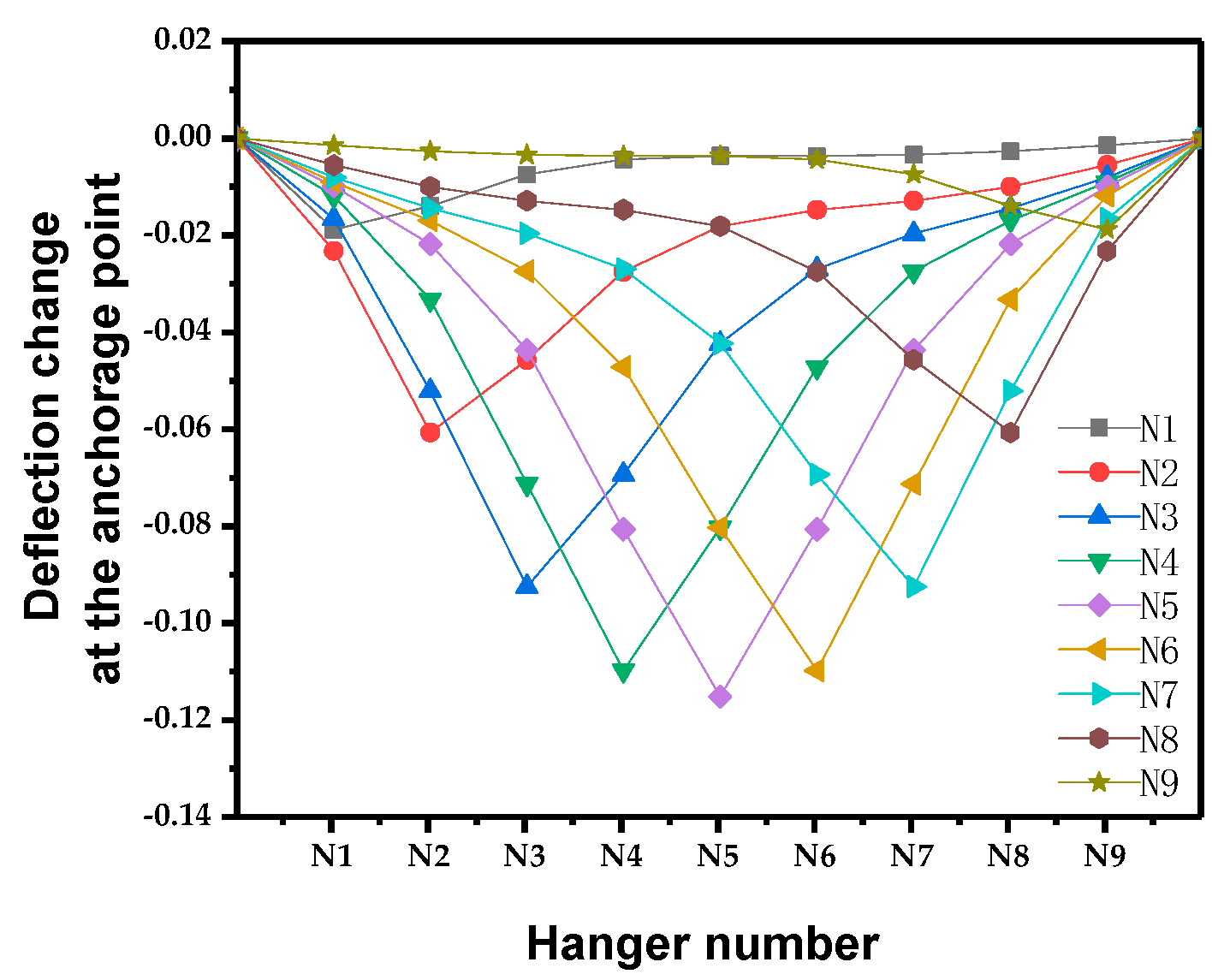

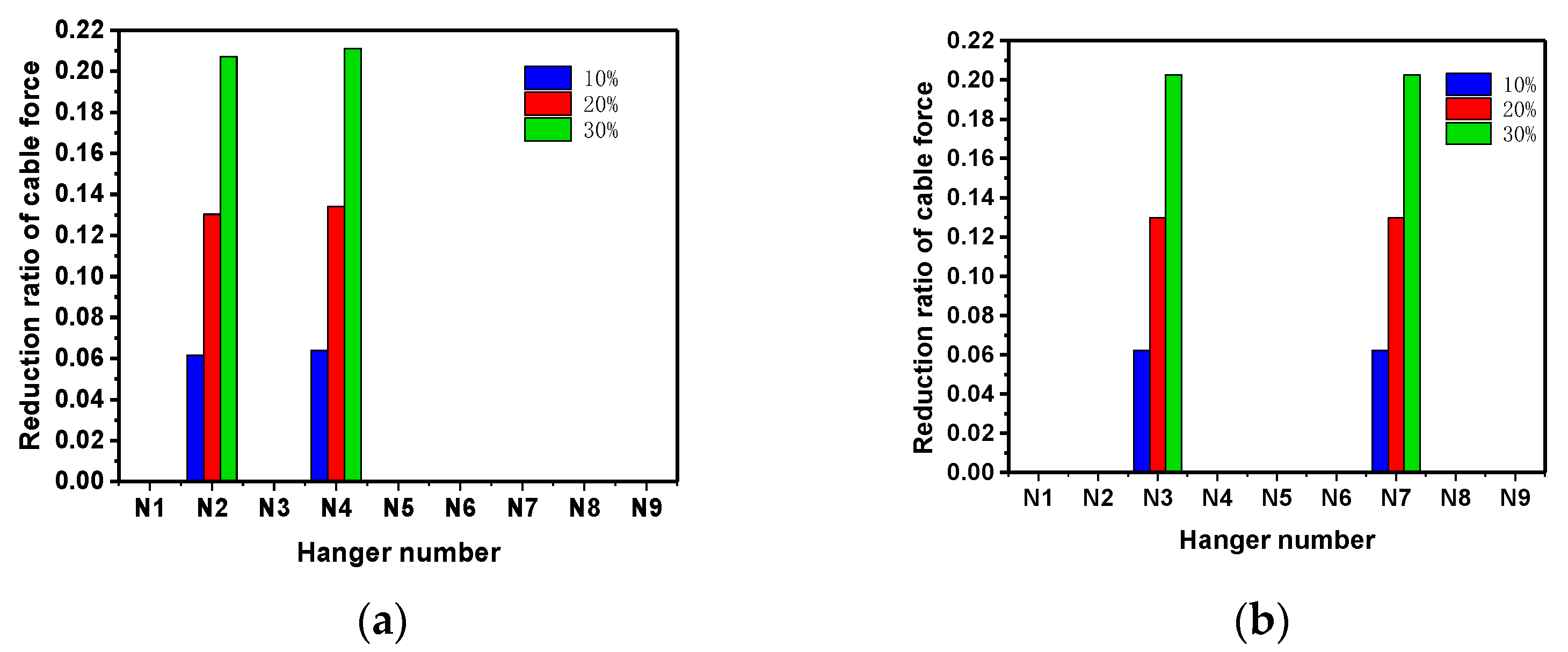
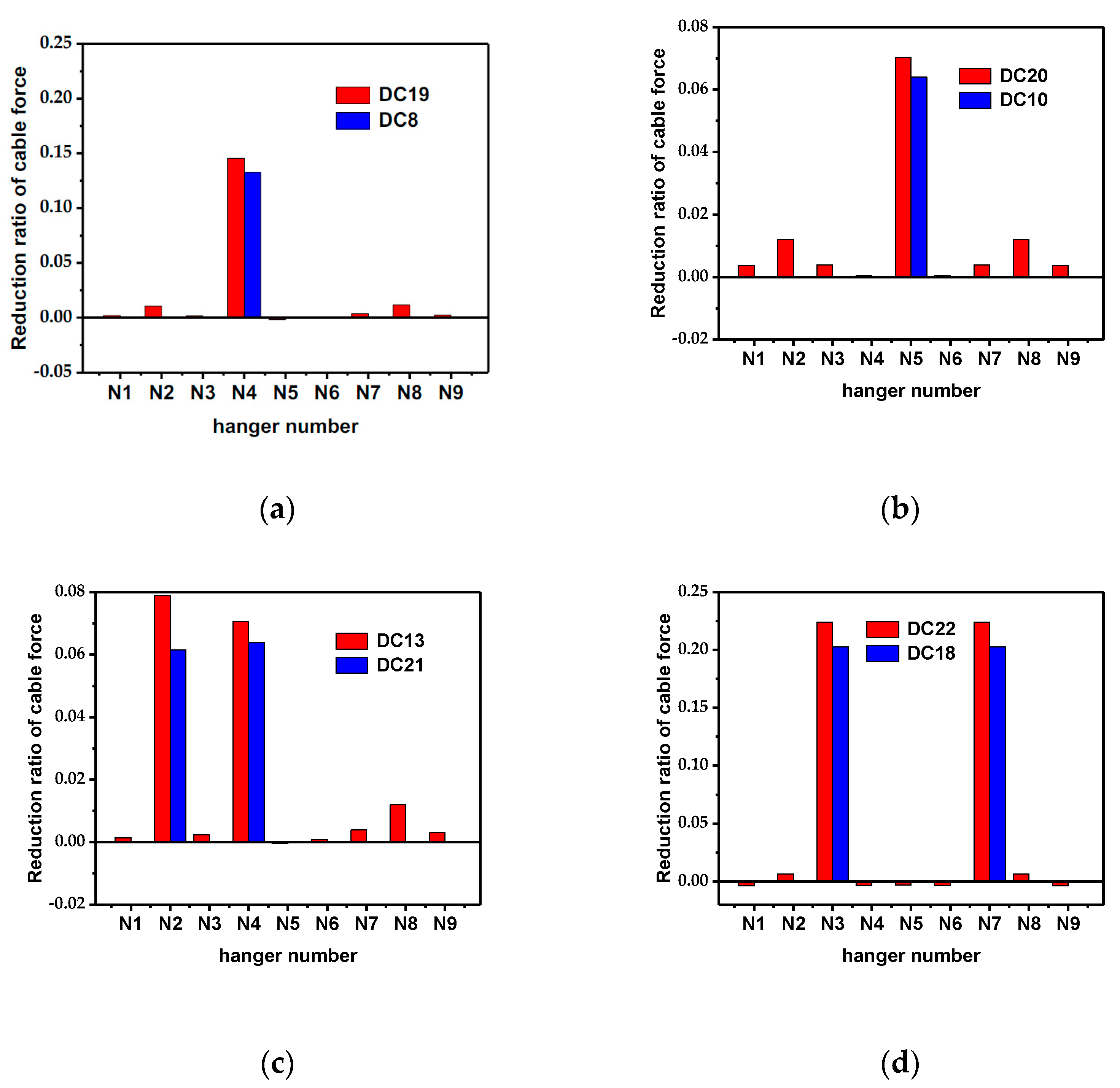
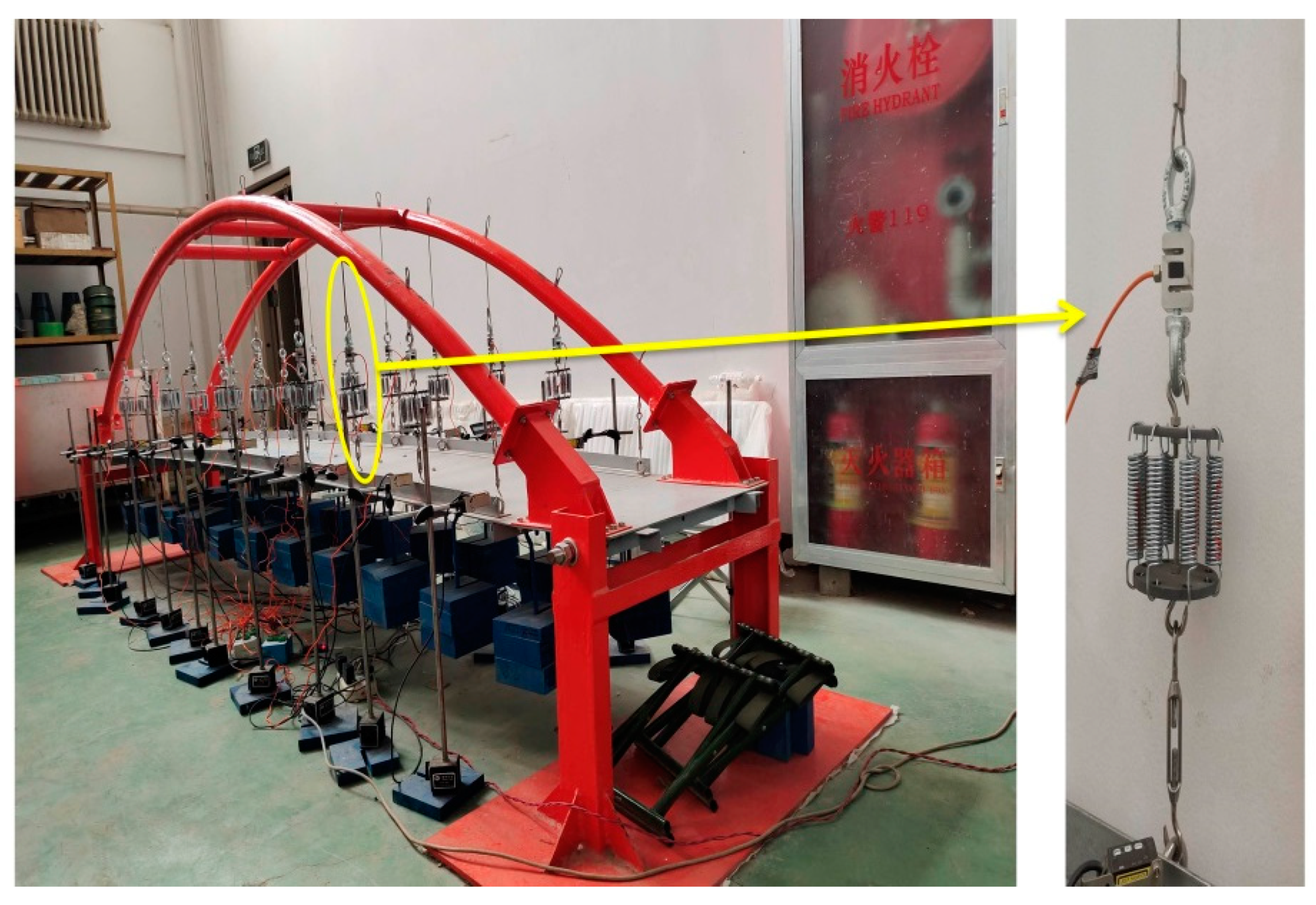


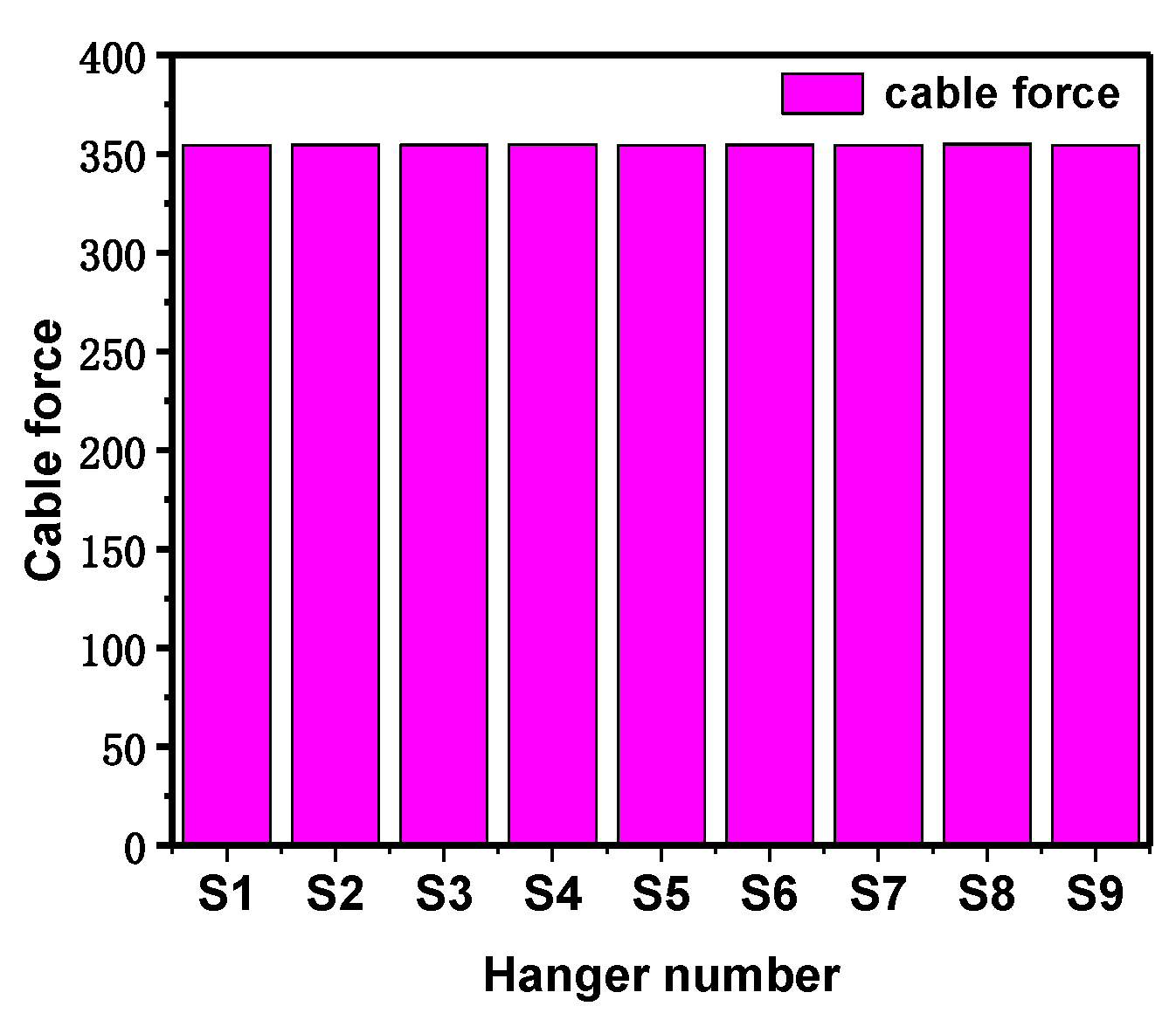
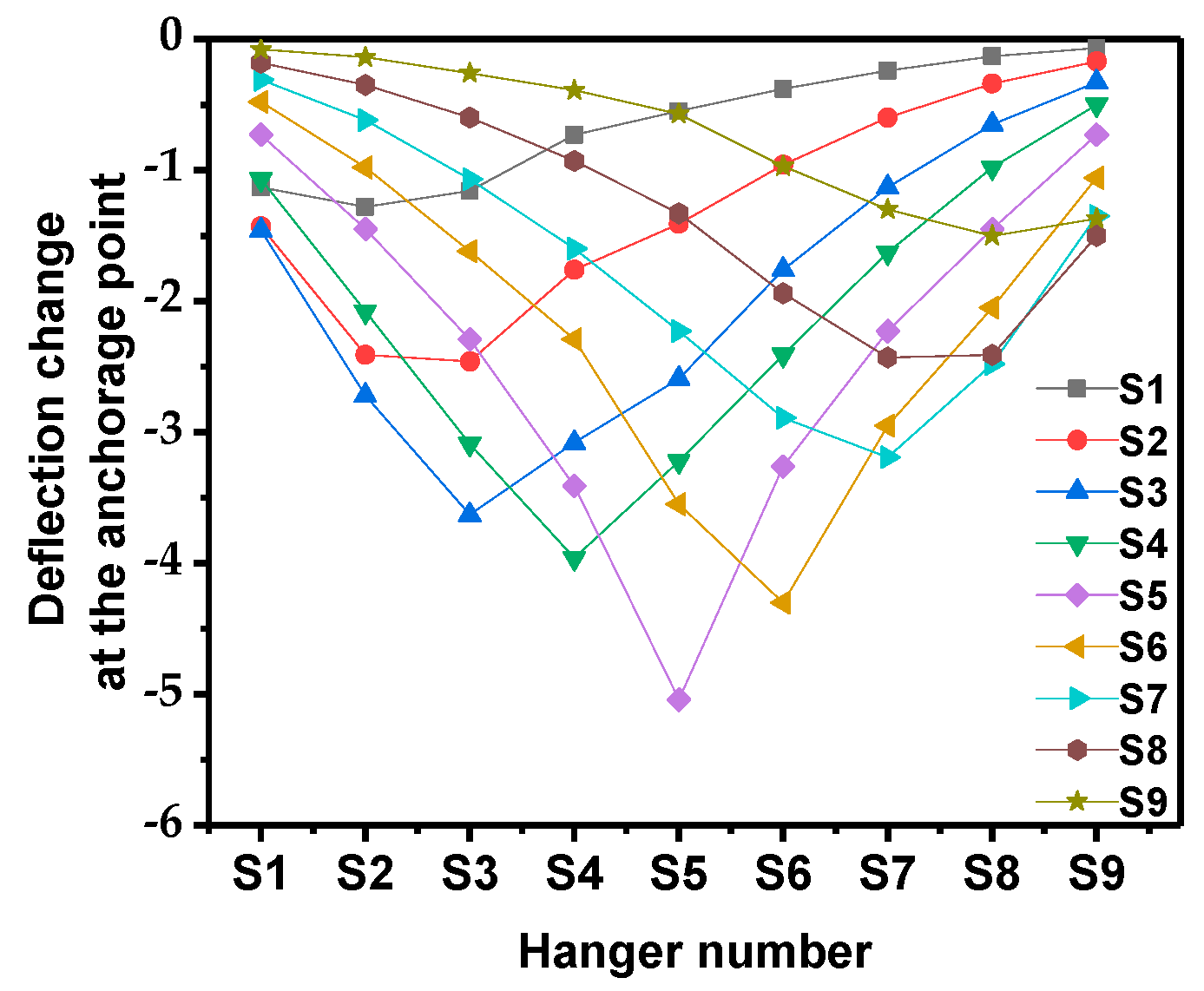
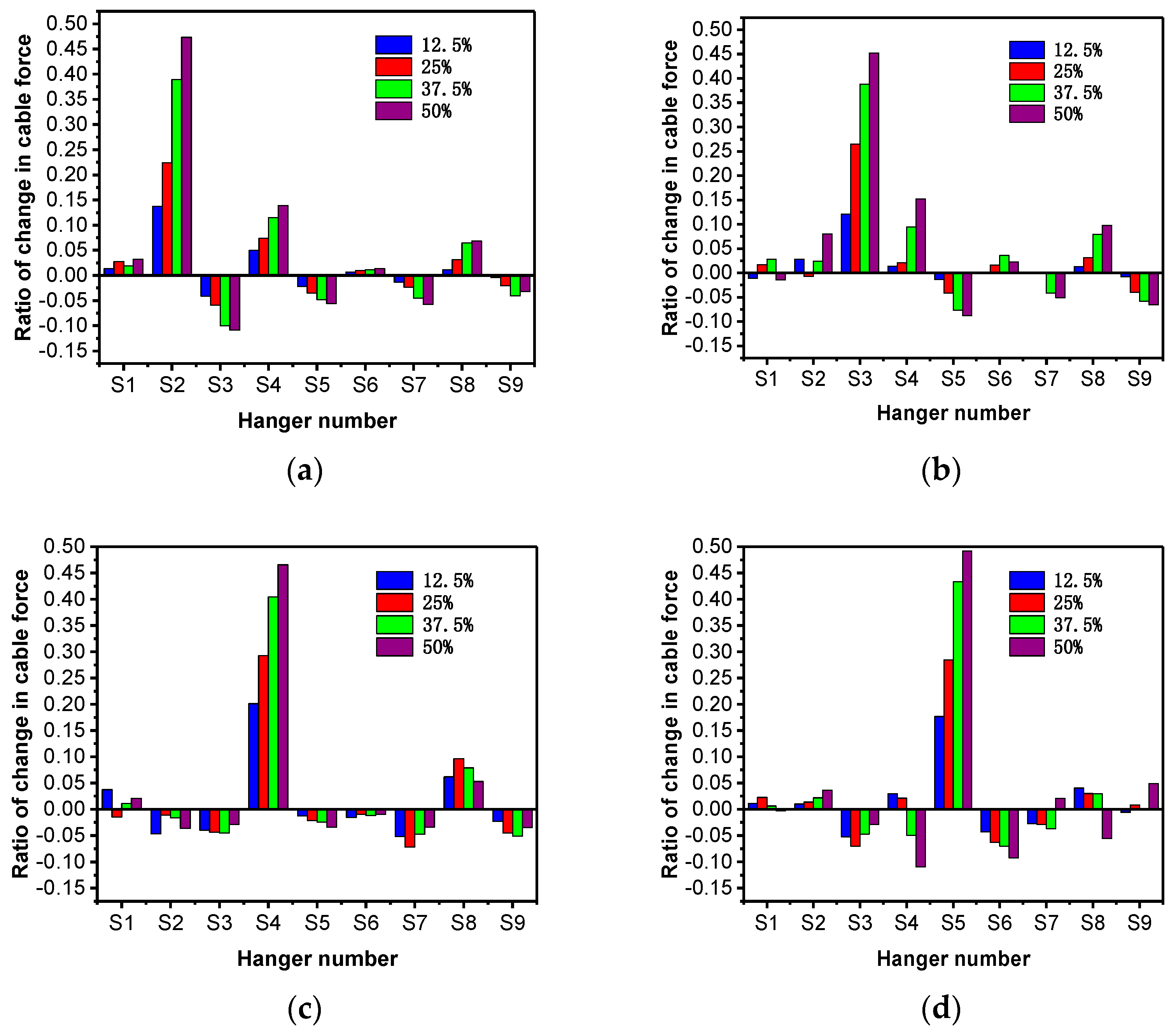
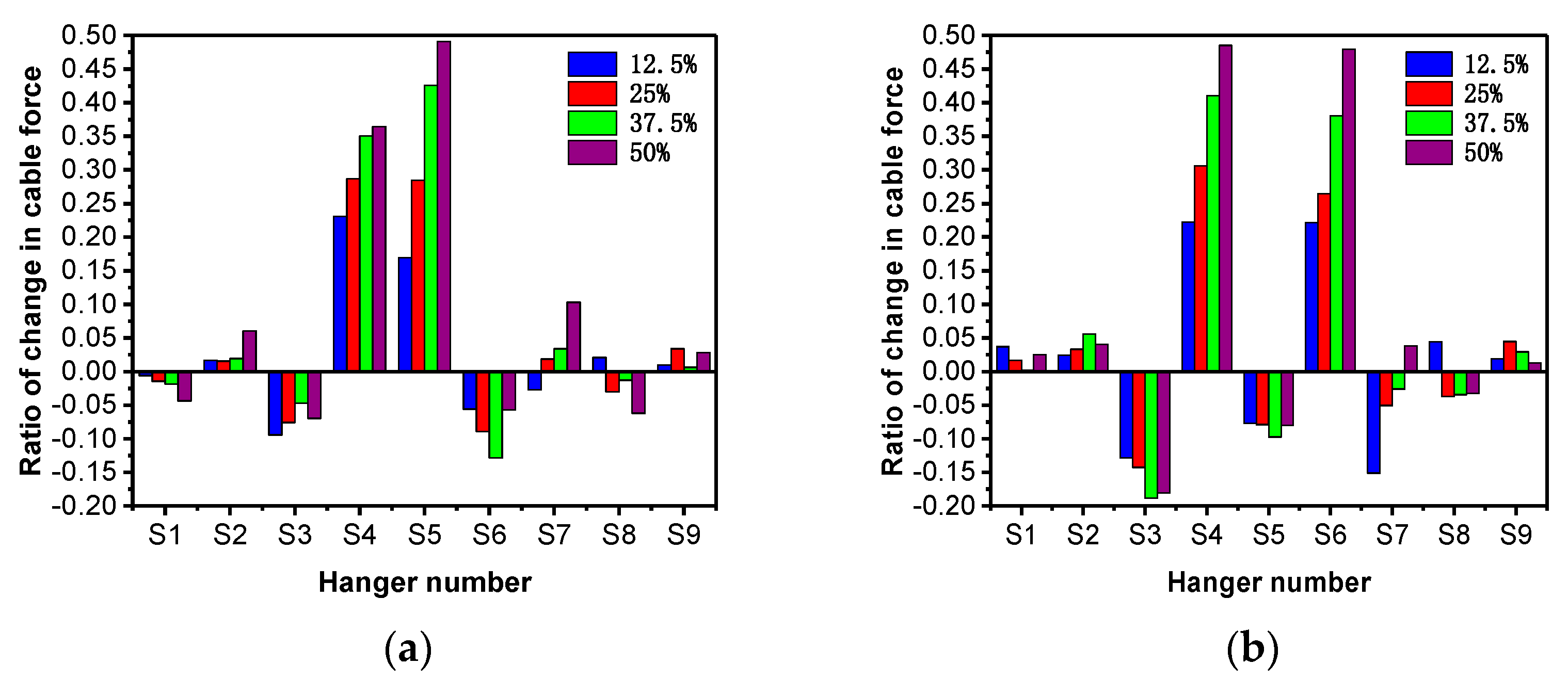
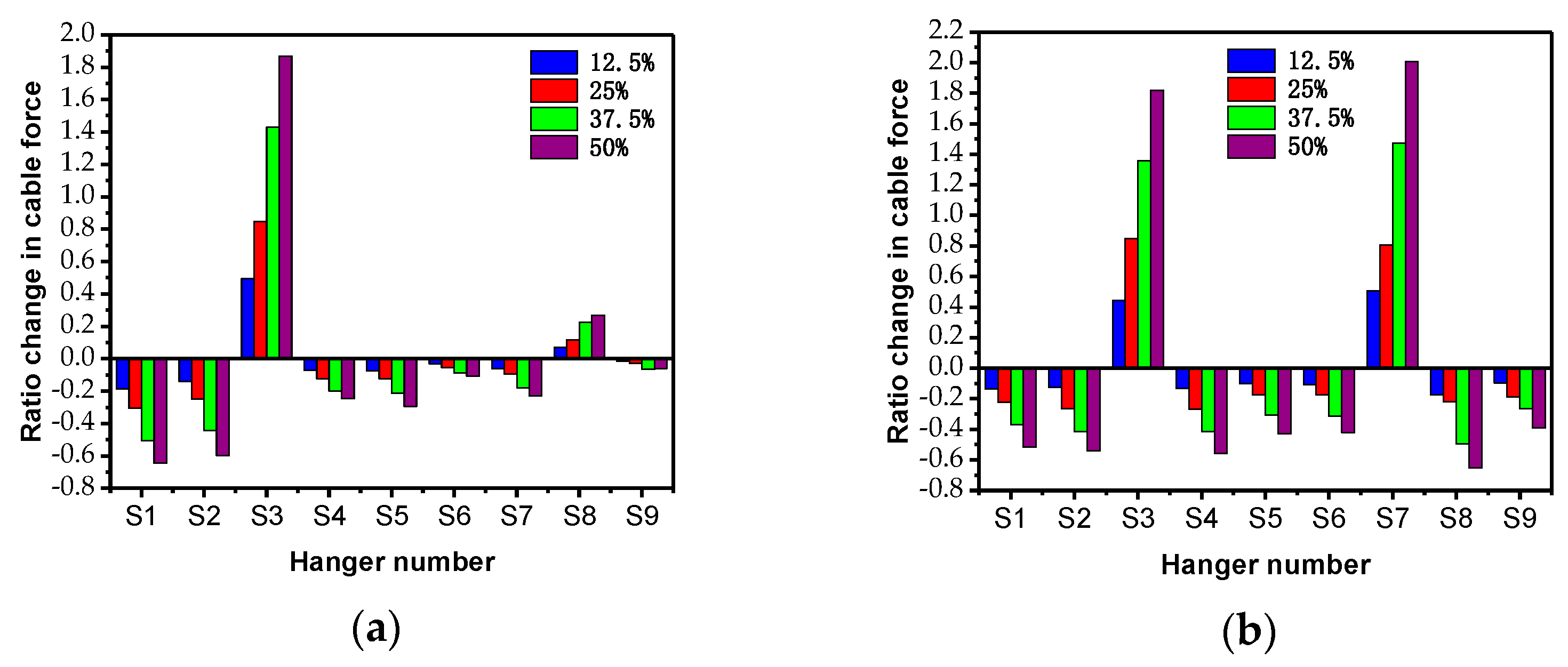
| Damage Type | Damage Case No. | Damage Hanger No. | Damage Degree |
|---|---|---|---|
| Single hanger failure | DC 1–3 | N2 | 10% 20% 30% |
| DC 4–6 | N3 | 10% 20% 30% | |
| DC 7–9 | N4 | 10% 20% 30% | |
| DC 10–12 | N5 | 10% 20% 30% | |
| Double hanger failure | DC 13–15 | N2 and N4 | 10% 20% 30% |
| DC 16–18 | N3 and N7 | 10% 20% 30% |
| Hanger No. | Damage Degree | ||
|---|---|---|---|
| 10% | 20% | 30% | |
| N2 | 0.0609/0.0609 | 0.1273/0.1273 | 0.1997/0.1997 |
| N3 | 0.0623/0.0623 | 0.1300/0.1300 | 0.2036/0.2036 |
| N4 | 0.0635/0.0635 | 0.1325/0.1325 | 0.2070/0.2070 |
| N5 | 0.0639/0.0639 | 0.1332/0.1332 | 0.2082/0.2082 |
| Hanger No. | Damage Degree | ||
|---|---|---|---|
| 10% | 20% | 30% | |
| N3 | 0.0622/0.0635 | 0.1297/0.1323 | 0.2027/0.2068 |
| N7 | 0.0622/0.0635 | 0.1297/0.1323 | 0.2027/0.2068 |
| N2 | 0.0615/0.0502 | 0.1303/0.1064 | 0.2072/0.1695 |
| N4 | 0.0639/0.0580 | 0.1341/0.1216 | 0.2112/0.1913 |
| Damage Type | Damage Case No. | Damage Hanger No. | Damage Degree |
|---|---|---|---|
| Single hanger failure | DC 19 | N4 | 20% |
| DC 20 | N5 | 10% | |
| Double hanger failure | DC 21 | N2 & N4 | 10% |
| DC 22 | N3 & N7 | 30% |
| Damage Type | Damage Case No. | Damage Hanger No. | Damage Degree |
|---|---|---|---|
| Single hanger failure | EDC 1–4 | S2 | 12.5% 25% 37.5% 50% |
| EDC 5–8 | S3 | 12.5% 25% 37.5% 50% | |
| EDC 9–12 | S4 | 12.5% 25% 37.5% 50% | |
| EDC 13–16 | S5 | 12.5% 25% 37.5% 50% | |
| Double hanger failure | EDC 17–20 | S4 & S5 | 12.5% 25% 37.5% 50% |
| EDC 21–24 | S4 & S6 | 12.5% 25% 37.5% 50% |
Publisher’s Note: MDPI stays neutral with regard to jurisdictional claims in published maps and institutional affiliations. |
© 2021 by the authors. Licensee MDPI, Basel, Switzerland. This article is an open access article distributed under the terms and conditions of the Creative Commons Attribution (CC BY) license (https://creativecommons.org/licenses/by/4.0/).
Share and Cite
Wang, W.; Su, M. Damage Identification in Hangers of Through-Arch Bridges Using Static Deflection Difference at the Anchorage Point. Appl. Sci. 2021, 11, 10780. https://doi.org/10.3390/app112210780
Wang W, Su M. Damage Identification in Hangers of Through-Arch Bridges Using Static Deflection Difference at the Anchorage Point. Applied Sciences. 2021; 11(22):10780. https://doi.org/10.3390/app112210780
Chicago/Turabian StyleWang, Weiwei, and Mubiao Su. 2021. "Damage Identification in Hangers of Through-Arch Bridges Using Static Deflection Difference at the Anchorage Point" Applied Sciences 11, no. 22: 10780. https://doi.org/10.3390/app112210780
APA StyleWang, W., & Su, M. (2021). Damage Identification in Hangers of Through-Arch Bridges Using Static Deflection Difference at the Anchorage Point. Applied Sciences, 11(22), 10780. https://doi.org/10.3390/app112210780






